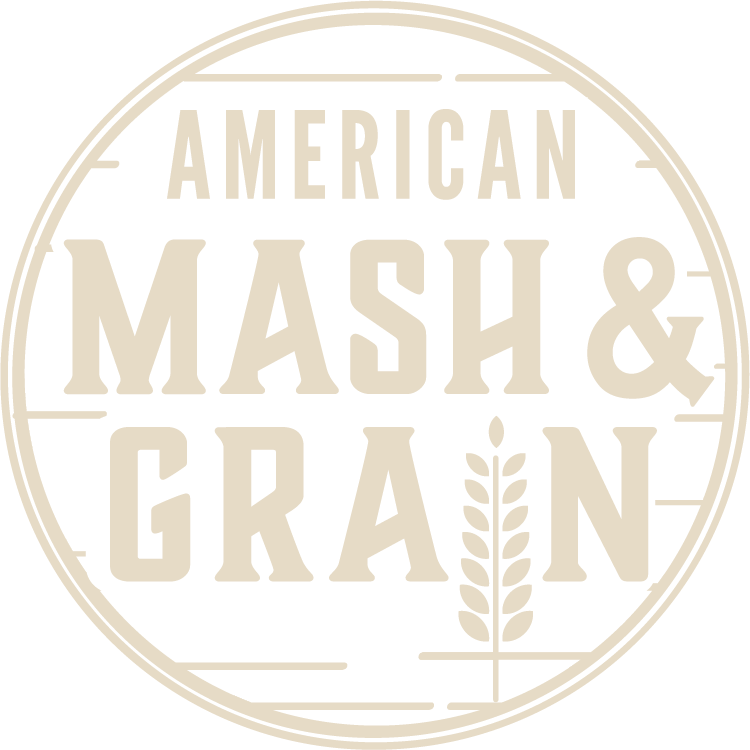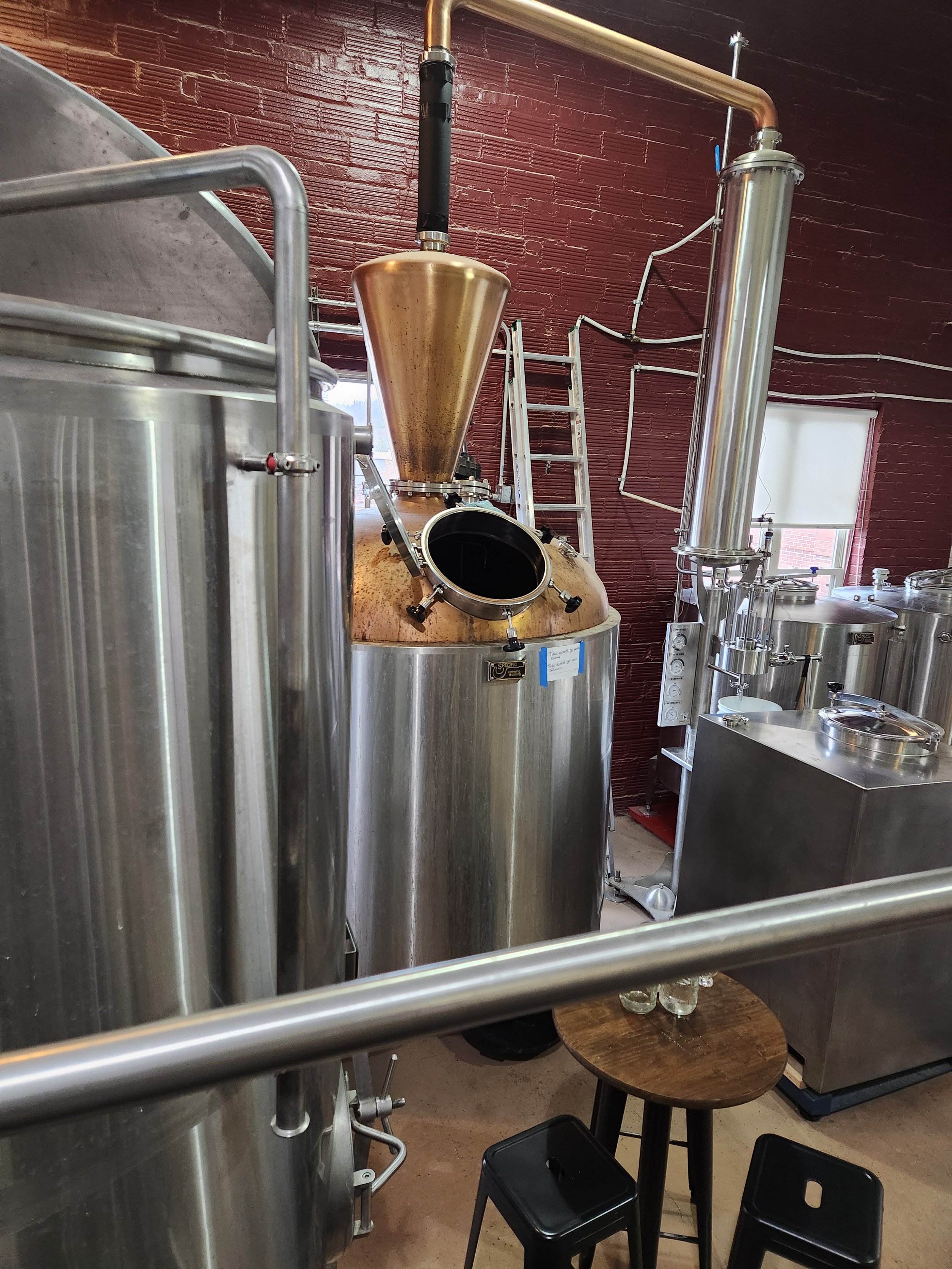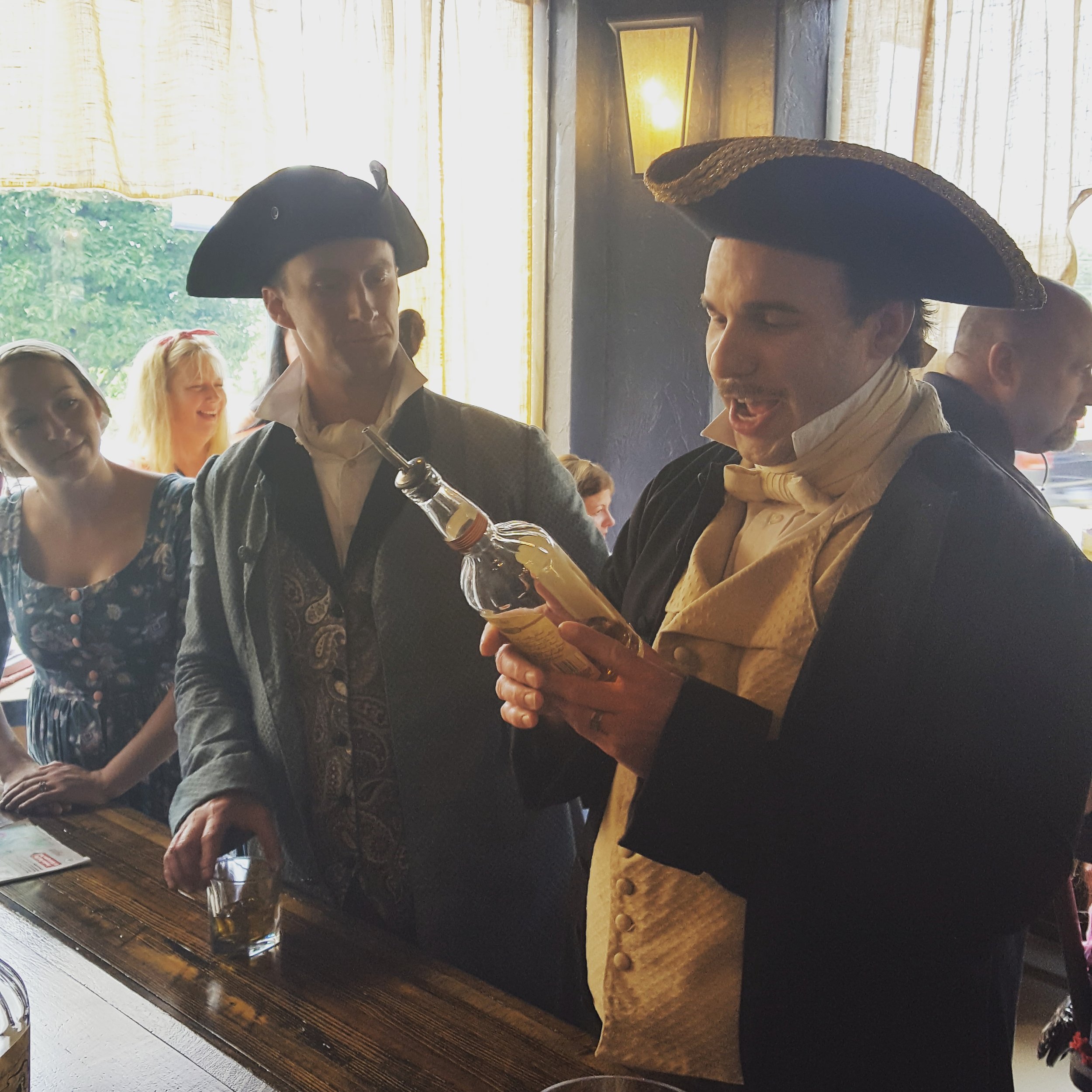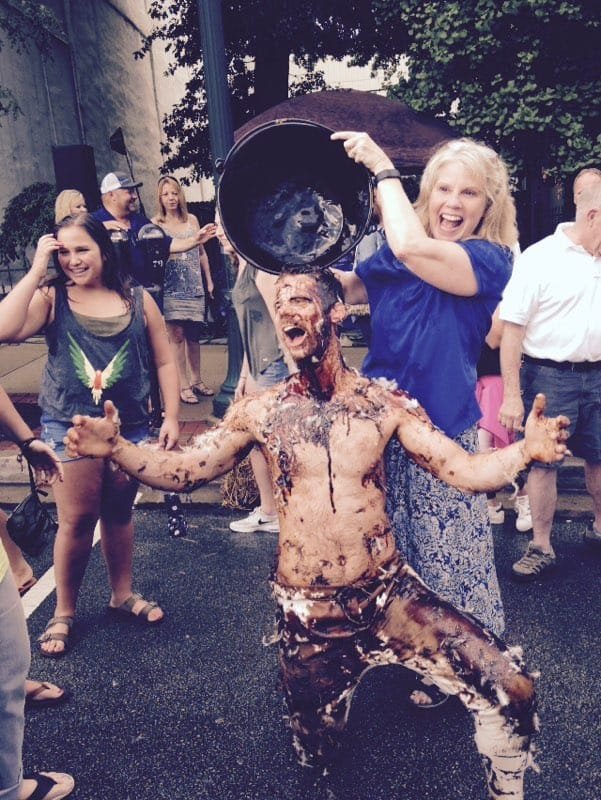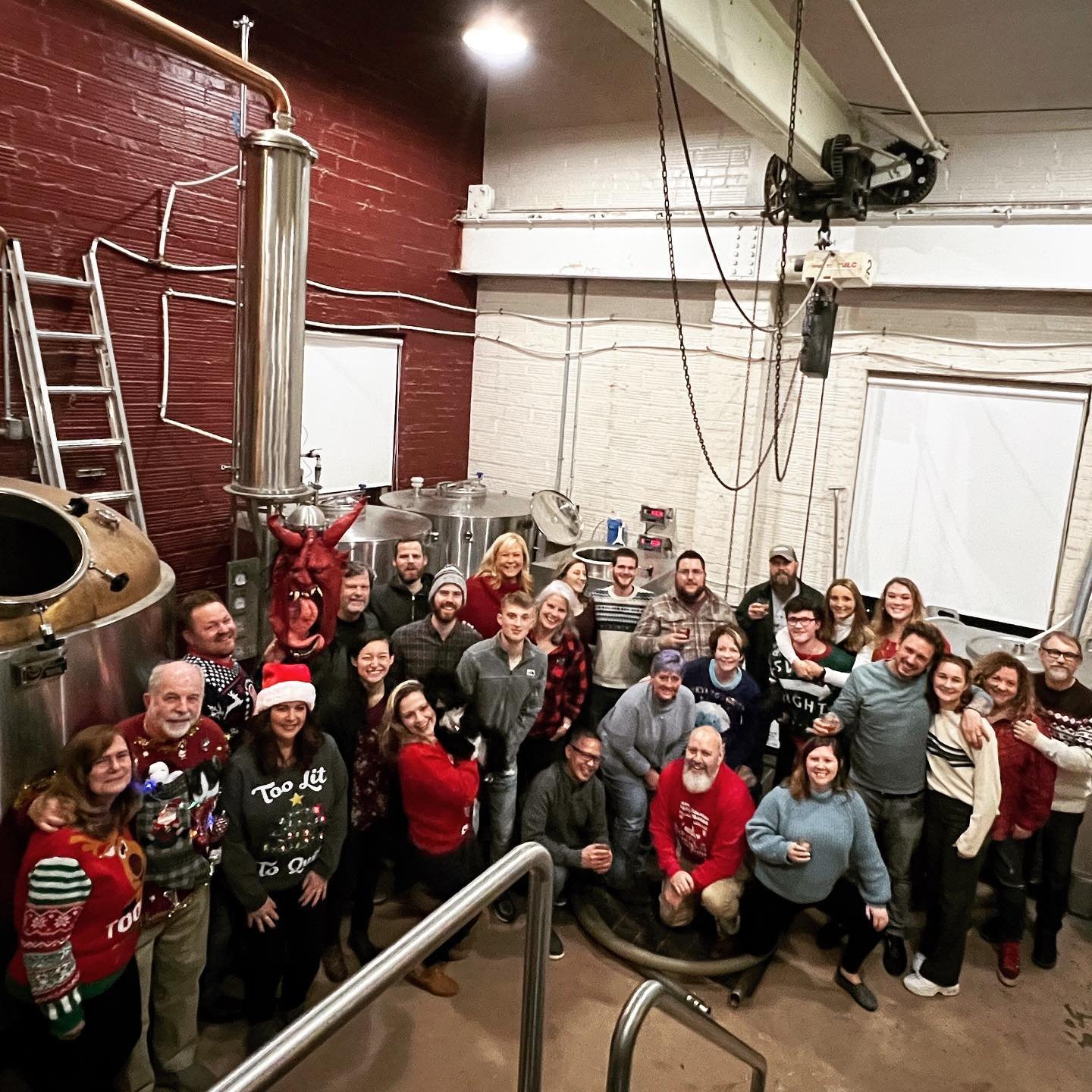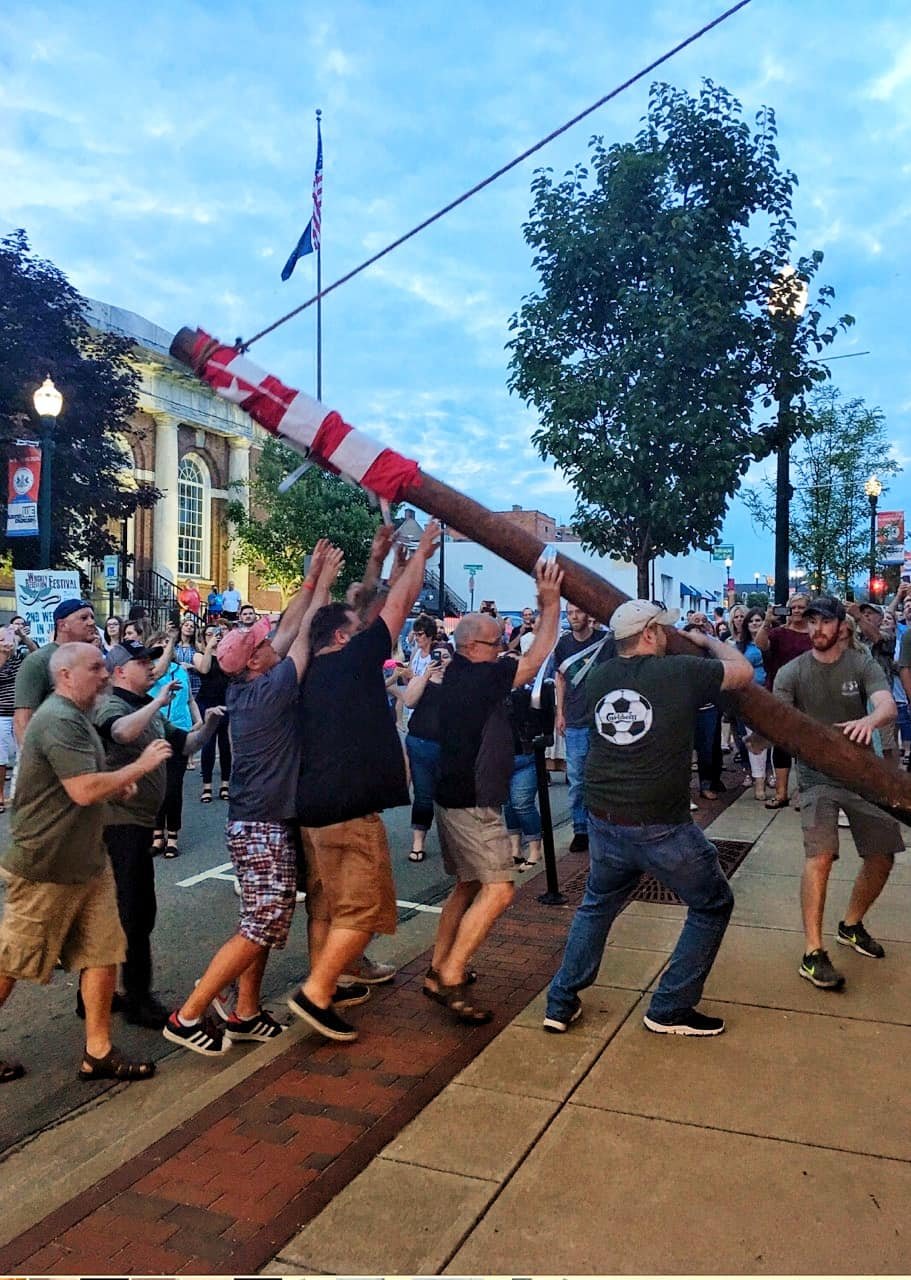Liberty Pole Spirits
By Meghan Swanson
Americans are known to be many things to our fellow nations of the world: Loud. Brash. New money. Fond of white sneakers, large portion sizes, and ice in our water. However, the one defining characteristic that has been proudly worn by Americans from day one is rebellious. We wouldn’t be the nation we are today without that nationally shared sense of justice that says to us, ‘Hey, who put them in charge?’ and prompts us to band together and do something about it. American craft whiskey is no exception to this rule. Further back even than the dust-up surrounding Prohibition, American farmer-distillers were rebelling against what they saw as an unfair status quo. They were the engine behind Western Pennsylvania’s Whiskey Rebellion of the 1790s, violently protesting the “whiskey tax” enacted by our nascent federal government. Jim Hough and his family, owners of Liberty Pole Spirits, honor the memory of those local residents that dared take a stance against what they perceived as an unfair tax.
“We knew we were going to be whiskey from the get-go…we knew that we had to focus on that history that is uniquely Western Pennsylvania.”
Jim Hough hasn’t always been a whiskey distiller. He spent his entire first career as an investment professional. He managed endowments, pension funds, foundations and the like for thirty years. “Pretty dry stuff,” he admits with a smile. His hobby, however, was anything but dry. In 2006, he picked up a 10-gallon hobby still and started distilling. “I had always been a whiskey fan, so I had a couple friends that were homebrewers and I tried brewing beer and didn’t find it fun…so I decided to go with my passion, which was whiskey.” he explains. Jim and his wife Ellen had, like so many parents of their age group, downsized when their adult sons left the nest. They moved to Washington, Pennsylvania–home of the Whiskey Rebellion, and the town that would become the home of their very own full-fledged distillery, although they didn’t know it yet.
In Washington, Ellen met the wife of Dr. Thomas Hart, a professor of botany at Washington & Jefferson College. They shared a mutual interest in the textile arts, and Ellen invited her to come see her quilt work some time. One night, as Jim happily tinkered away on his hobby still on their back porch, Dr. and Mrs. Hart were out for an evening stroll in the neighborhood and decided to drop in on Ellen to see those quilts. Ellen had always felt a degree of nervousness around Jim’s hobby, and she flinched when the doorbell rang. “My wife, when the doorbell rang, she thought it was the Feds.” Jim laughs. Ellen showed the couple in, touring them through the house and talking textiles, hoping that the Harts wouldn’t notice Jim out back on his illegal still. It was in vain; Dr. Hart knew exactly what Jim was up to out there. Instead of an admonishment, he offered Jim and Ellen encouragement. He thought it was high time Washington, home of the Whiskey Rebellion, had its own craft distillery–and he thought Jim and Ellen should consider being the ones to start it.
That might have been nothing but a pleasant dream to Jim and Ellen, had another incident not shown them there was true merit in the idea. Jim is an American whiskey fan, and he started out making bourbon, rye whiskey, and corn whiskey. Ellen, however, is what Jim terms a ‘dirt-eater’; she drinks Scotch, and “She loves the peat.” he tells us. Jim had noticed her aversion to the risk surrounding his home distilling. “In order for me to have the green light to continue to play with my hobby, I figured I should make a whiskey that she would find appealing.” he explains. Jim decided he would make Ellen a peated bourbon; Ellen liked what he made. He took a sample of his efforts to share with some golf buddies, eager to see what someone else thought. The first two friends proved a disappointing test audience. “Pittsburgh is a shot-and-a-beer town. So two of my friends are true Pittsburghers, true yinzers, not whiskey guys, they picked it up, and–boom. It was down the hatch.” he says ruefully. “My third buddy, Ian, is from Britain…he’s a real whiskey lover.” Jim explains. Ian sipped the whiskey, nosed it, savored it…he had Jim on tenterhooks. Did he like it, or not? “He took the last sip, slammed the glass down on the table and said, ‘that’s bloody fantastic!’” Jim recalls with a grin. That was it - he needed to see where this ‘hobby’ would take him.
“I’ve had a long career. I’ve worked in a couple of different fields, and there’s no comparison.”
Jim had a steady, successful career in investing, with just one problem: he was burning out. He looked ahead to the ten or twelve years he was certain to work until retirement with dismay. He couldn’t be the kind of person who just existed, spending their days at a job they care nothing for. It was time to build what he called his ‘career 2.0’. He made a three-year exit plan with his firm, allowing him to slowly off-ramp while they worked to replace his essential role. “I was able to get a paycheck, have healthcare coverage, which–y’know, in hindsight, was absolutely essential to starting a whiskey distillery. It was that safety net that kind of really allowed us to navigate those first couple of years.” he says. From the start, Jim took a ‘brutal’ path of small-barrel progressions, and made the deliberate choice not to dabble in any white spirits. There would be no gin, no vodka to keep the lights on in those early days. “We’re all-in. That Whiskey Rebellion–that whiskey vibe defines everything we do.” Jim explains.
Fortunately, he and Ellen didn’t know at the start how tough it would really be. “Naivete,” Jim quips, “is the engine that drives entrepreneurship.” They began to put their business plan together in 2014, after Jim had spent eight years hobby-distilling. Jim describes craft whiskey as being ‘infant’ back then; he recalls that their distilled spirits plant permit was only the 1000th one the TTB had granted. For context, today there are over 3,000 and counting. “I really enjoyed the process. I visited a bunch of distilleries. I found the people intriguing and engaging, everybody was just–it was a community. People were always willing to talk, and help, and answer questions, and I wanted to be a part of that.” Jim recalls getting started.
They started with a smaller-scale plan, imagining themselves in charge of a very small-scale operation. Perhaps something appropriately sized for a husband and wife to preside over in retirement. When they found the right space for the distillery, however, it demanded they operate on a larger scale than they had anticipated. They started to talk about hiring help for their project. That’s when sons Rob and Kevin took an interest in their parents’ distillery dream. “I think in the few short years they had started working in corporate America, they had learned they didn’t like the cubicle life. They had been distilling with me on the deck for probably their entire middle and high school lifetimes, so they were well aware of…what distillation was.” Jim tells us. He and Ellen were hesitant; Rob and Kevin both had ‘really great’ jobs, Jim says, and they didn’t want to see them leave those jobs to take a risk that might not pan out. But they made a compelling case, and in time came aboard. “Family businesses are tricky to navigate, you know; egos, relationships, and everything else. But everybody settled into their area of passion.”
Rob, the elder Hough son, is now the head distiller. He’s always had powerful senses, causing him irritation as a child; Jim describes Rob being upset by the particular texture of the faux-fur collar on a winter coat, or by the ghostly aroma of onions cooked in the house hours before he arrived home from school. Now, Jim describes Rob’s enhanced senses as an incredible gift in the art of distilling. Younger son Kevin is the CEO of the brand, handling the distillery’s books and finances and project-managing their upcoming new distillery build. Wife Ellen is the mind behind Liberty Pole’s branding, customers’ distillery experience, and the robust cocktail program Jim credits with getting them through those early years. And Jim? He describes himself as the brand ambassador and sometimes, man-of-all-work. “I shake hands, kiss babies, do whatever needs done in the distillery.” he tells us with a smile. “We’ve all formed these roles that we’re all pretty happy in.” he explains with obvious pride and contentment.
“We want you to feel like you are sitting in a meeting-house in 1794 planning to tar and feather the next tax-collector that comes up your drive.”
Liberty Pole’s tasting room is very deliberately, deeply Colonial in atmosphere. The back bar is a Colonial-era fireplace, all square, roughened stones sandwiched neatly together with thick layers of mortar. While the lights are electric, they’re couched inside lantern-shaped sconces that fool the eye into thinking that maybe, just maybe, it’s whale oil burning brightly inside. The walls are painted a distinctive Federal blue, the stately shade just bordering on gray, and behind the bar a gilt portrait of Alexander Hamilton hangs–upside down. It’s a bit of cheeky disrespect to the man behind the tax that Washington’s historic residents rose up against.
When the Houghs incorporated, they didn’t yet have the fully-formed picture of what Liberty Pole Spirits would become. In the spirit of the region’s history, they named themselves Mingo Creek Craft Distillers. The Mingo Creek Society was the one-time name of the Whiskey Rebellion’s driving engine, headed up by Washingtonian David Bradford. It would be another friend who brought them the idea of the liberty pole itself; one of Ellen’s friends texted her one day after reading about ‘liberty poles’. Common during the American Revolution, they are a concept that dates back to Roman times; when Julius Caesar was killed, the ‘Liberatores’, as they called themselves, paraded through the streets with a cap carried on the tip of a spear. The practice was revived in Europe during the Renaissance, and lived on to eventually become a part of America’s rebellion against English dominance. The name ‘Liberty Pole Spirits’ would become the Budweiser to Mingo Creek’s Anheuser-Busch.
When we spoke to Jim for this article, Liberty Pole was in the midst of a design refresh. One design element that will stay on their label for sure is the Revolutionary-era woman who holds the liberty pole. She’s a representation of an actual historical figure: Jane Miller. The Miller family homestead wasn’t too far from present-day Washington, and like so many of their neighbors, they distilled their own whiskey to help make ends meet. They were part of the Whiskey Rebellion, of course, and when passions were stoked high enough for the townsfolk to march on the local tax collector’s house, they were caught up in the crowd too. In the fracas, the younger son of the Neville family was shot. He lived to be carried away from the scene, but the wound in his leg became infected, and he succumbed to sepsis days later. His mother, Jane, wrote of the family’s loss in her diary: ‘Curse the wilderness where there are no doctors.’ The story touched Jim and Ellen’s hearts, and they decided to put Jane Miller on their bottles. Her likeness, ‘Spirited Jane’, symbolizes the struggles of the common people of Washington, from her days when it was the wild frontier of America to the past few decades’ loss of the local steel and glass industries.
“You have to do things to set yourself apart. We’ll never out-Jim-Beam Jim Beam.”
When Jim got serious about the distilling business, the first thing he was going to need was a bigger still. His 10-gallon hobby still from a mail-order business out of Arkansas wasn’t going to cut it - he decided to go up to a 300-gallon still with an inverted ‘whiskey head’ from Trident Stills in Maine. “Scaling up, believe it or not, was not a problem. It’s easier to make better whiskey on a bigger still.” Jim explains. “It’s much easier to make those phase transitions, those cuts, when you have a little bit more wiggle room in that distillation.” he tells us. As they grew, they sized up again, this time to 600 gallons. They loved the design of their Trident still, and wanted the new, bigger still to match. Rob and Kevin sent out a design for a still that included the ‘whiskey head’, and Specific Mechanical Systems of Victoria, B.C., answered the call.. They built the 600 gallon still, and Jim says the consistency between the two stills was great. The 600 gallon still has been up and running since 2019, helping Liberty Pole fill 53-gallon barrels.
The transition to a bigger barrel was much less easy than the transition to the bigger still, according to Jim. “That was kind of a scary move for us, to make that transition,'' he admits. The bigger barrels make better whiskey, in his opinion, but they take a lot longer to age. “That’s one of the reasons we don’t enter many competitions, nor have we really explored wider Distribution - we’re not available on any direct to consumer shippers outside of Pennsylvania…we’re really trying to control our inventory and maintain our momentum here in Western Pennsylvania.” he tells us. He does make some exceptions in the name of competition; one night, he poured some of their peated rye bourbon into a glass flask, labeled it by hand with Sharpie and blue painter’s tape, and sent it off to whiskey connoisseur, Fred Minnick. Fred, as expected, never wrote back. To Liberty Pole’s delight, however, he ended up rating it #50 in his top 100 American whiskeys of 2021. That peated rye is something Jim is proud of. “When you taste that peated bourbon, you’re really gonna get the peat. The corn lets the peat dominate it. But that peated rye? Rye is a strong grain, it really holds its own.” he explains.
When it comes to grain, the Hough family has a special fondness for Bloody Butcher corn. “We’re really pot still fans, we love a good pot still whiskey. We’re kind of shouting from the mountaintops as often as we can about pot still whiskey, and we just thought it made a really awesome distillate.” Jim says. “We distilled several varieties of corn…and we all just really liked the Bloody Butcher.” he shrugs. It’s one of the ways in which Jim believes Liberty Pole Spirits stays competitive. “I always think about when I started this, talking to guys who had gone into the craft brewing business, they basically only had to make something that was better than Budweiser because the national brands weren’t very good. We’re not that fortunate. Maker’s Mark is a hell of a whiskey - the heritage brands make really good products and they make them cheaper than we do.” he lays it out. On the other hand, “The…nice thing about Bloody Butcher is…it’s got a little uniqueness to it. It’s something that Jim Beam, and Maker’s Mark, the heritage guys, are never going to be able to produce a heritage corn whiskey. They couldn’t get enough of it, the yield wouldn’t be enough for them.” he says.
Yield is something that Jim has in mind always; it’s why they put their distillate in the barrel at 108 proof. That lower entry proof draws in more of the barrel sugars than a higher proof would. “We like that because the sugars, the barrel sugars, they’re more soluble with water than they are with alcohol.” he explains. They combine a ‘heavy-medium’ toast with a level 3 char to really help caramelize those sugars. “As a young distillery, we would have loved to be able to sit on our barrels for four, six, eight years, and we are getting close to that goal. The reality though is that we do have to bottle some 2 to 3 year old whiskey currently so we want to make the best whiskey we can make at that younger age.” Jim says It seems to be working - their bourbon, rye, and peated bourbon have all won medals with the American Craft Spirits Association within the last five years.
“It’s definitely good to be a whiskey distiller in a town that holds a Whiskey Rebellion Festival.”
Liberty Pole Spirits didn’t just come up with their branding out of thin air, and they’re not the only ones who celebrate the town’s rebellious history. Every summer, the entire town of Washington throws a Whiskey Rebellion Festival with food, music, drinks (naturally), and a ceremonial tar-and-feathering of the ‘tax collector’. “For us, being a whiskey distillery in town, it’s our Super Bowl. We plan for a month to get ready, we tent up the back parking lot, we have music, we have our own food truck. We set up a couple of spillover bars. It’s just a really fun couple of days for us.” Jim shares with a smile. Rob and Kevin have each served as the ‘tax collector’ in past years, enduring the application of the chocolate-and-molasses ‘tar’. Jim hasn’t done it yet, and thinks he might like to someday; but he isn’t as keen on the follow-up, where the tarred-and-feathered tax collector is taken behind the fire station and blasted clean with a hose.
Obviously, Washington was primed for Liberty Pole Spirits to launch. Jim considers himself very lucky; in many towns, distilleries are looked at as an unknown. Authorities throw up roadblocks, and it can be hard to get started. “In a town like Washington, we had a pretty easy path to opening up because they were so anxious to have a whiskey distillery in town.” he recalls. He also acknowledges their very good fortune to be in the state of Pennsylvania, which allows distilleries to mix and serve cocktails. “Don’t neglect the cocktail aspect of a distillery. It’s important.” he advises. “Our cocktail program really bought us some goodwill with our customers [early on]. They had such a good time, such great cocktails that even though they were drinking whiskey out of 5, 10 gallon barrels that had a ways to go [they didn’t mind].” he remembers. The cocktail program was a challenge in customer education; Jim and Ellen needed to show people there was more to whiskey than they might have thought. “You don’t have to shoot it [whiskey] right next to an Iron City beer. You can make really good cocktails.” he explains.
The people learned quickly, and Liberty Pole’s star continues to rise. They just broke ground on a new distillery this past May, hoping to have the new space open next summer. “We’re elevating ourselves to a higher level, just a better experience.” Jim tells us. The new three-building campus will have a bigger production area, a rickhouse from Buzick Construction out of Kentucky, and an updated tasting room with a small kitchen (they’ll keep the Colonial atmosphere). In the new distillery space, they’ll size up to a 1,000 gallon still from Vendome Copper and Brassworks. They’ll keep their 600 gallon still for finishing. Once they’re up and running, they’ll give tours of the campus and hope to become a whiskey destination for interested people from all over the region to visit. “We’ll never replace Kentucky, but we’ll be an option for people who maybe have never been to a fully functioning distillery.” Jim says. It’s all in service to his dream, which is to get Pennsylvania’s whiskeys back on the map. “The more serious whiskey distilleries that pop up in the region, I think it elevates everybody. We would really like to return Pennsylvania to prominence in the whiskey–especially the rye whiskey–world.” he shares.
“I wish I would’ve done it ten years earlier when I first had the idea to do it.”
Although Jim doesn’t think of himself and his family as rebels–“We’re rule-followers, we dutifully pay our taxes,” he is quick to point out–he certainly bucked the status quo when he switched from investment portfolios to mash bills. And although the Whiskey Rebellion itself is widely regarded by historians as an event that favorably demonstrated the new federal government’s power, its defiant legacy lives on in the people of Washington. Liberty Pole Spirits, lifting up historical figures like Jane Miller and thumbing its nose at Alexander Hamilton, is carrying that revolutionary, early-American spirit on. “It’s an honor for us to be that business in town that really meshes with the town’s history and identity.” Jim says. In Washington, look for Spirited Jane. Stop in under the liberty pole, give ol’ Alex a nod (or another gesture, no one will judge you), and take a smoky-sweet sip of their peated bourbon. Feel its fire run through your veins like the righteous anger of an American frontier farmer-distiller, and honor those brave souls who took up arms long ago. If you see Jim around the distillery, smiling as he goes about his day, just remember: sometimes, it’s good to be a little rebellious.
Tasting Notes
Straight Rye Whiskey (46% ABV)
Nose: Cinnamon Raisin Bread, Molasses, Green Apple, Fresh Cut Grass
Palate: The mouthfeel is soft, silky and refreshing with sweet notes of orange zest, brown sugar and cinnamon up front. Subtle baking spices along with dark chocolate truffle sweep in gently in the mid palate leading to a medium finish with hints of lemon, light oak, cinnamon and cola.
This is a fantastic rye whiskey. Flavorful, complex and well balanced. The mouthfeel is very inviting and allows you to enjoy the waves of flavor from start to finish.
Straight Bourbon (46% ABV)
Nose: Almond Croissant, Brandied Cherries, Sweet Corn.
Palate: The mouthfeel is similarly soft and silky. Once again the whiskey is sweet up front, with notes of cherry syrup and vanilla. Allspice and nutmeg emerge in the midpalate along with nutty flavors leading to a short vanilla and malty finish.
Another very nice whiskey, but this one is a bit more tame than the Straight Rye. There is plenty of sweetness to be enjoyed for classic bourbon fans, but the Bloody Butcher Corn adds those nutty savory notes and rich mouthfeel on the palate.
Straight Peated Bourbon (46% ABV)
Nose: Dark Chocolate, Leather, Freshly Cut Wood, Light Peat
Palate: The mouthfeel is once again soft and lightly oily/coating. The flavors are sweet up front with nut milk, vanilla and caramel. Black pepper comes through in the mid palate with hints of smoke and ash that settles into sweet and savory notes of dark salted chocolate, charred bell pepper and cinnamon for a long finish.
The peat really takes control of this whiskey. There is still enough sweetness to recognize it as a bourbon, but the smoky/savory notes are impossible to miss and make this whiskey a nice balance between American and Scottish flavors. Having tasted this, we are very intrigued to taste the Peated Rye and see how the peat balances against a more hardy grain.
Straight High Rye Bourbon (54.8% ABV)
Nose: Oatmeal Raisin Cookie, Cinnamon, Oak, Licorice
Palate: The mouthfeel is soft and chewy with up front flavors of stewed apples, salted caramel brown sugar and cinnamon. Bready flavors like the crispy exterior of a homemade bread are balanced with black pepper and clove in the mid palate leading to a long finish of dark chocolate, toasted malt, slight citrus and cinnamon.
This is a phenomenal whiskey. It’s a close call between this one and the Straight Rye, but the extra ABV on this one lends a bit more to the body making for a very enjoyable experience from beginning to end. You’re really getting the best of both worlds from this high rye mash bill. Nice sweetness from the corn and the barrel with well balanced spicy/savory notes.
